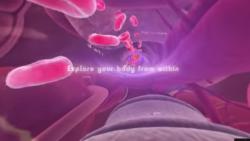Experience The Power Of VR Medical Animation
Hollywood dreams of a future that involves “looking inside” the human body. With the evolution of modern medicine and technology, we are seemingly moving closer to realizing this dream.
Virtual Reality or VR Medical Animation has already made it possible to not just ‘view’ but even ‘be’ in fabricated environments and experience them as real as possible. Using this tech, we’ve designed an animated 360 degree guided tour inside the human heart.
But, before we get into it, we must know where we’re headed to. So let’s brush up the heart’s basic structure and how the blood flows through it.
The four-chambered organ is divided into the left and right side by a muscular wall called the septum. The right and left sides of the heart are further divided into 2 auricles (top chambers that receive blood from the veins), and 2 ventricles (bottom chambers that pump blood into the arteries). The auricles and ventricles work together, contracting and relaxing to pump blood out of the heart.
As blood leaves each chamber of the heart, it passes through valves that are guarded by flaps or cusps. There are four heart valves within the heart: mitral valve, tricuspid valve, aortic valve, pulmonary valve. The mitral valve has two flaps; the others have three.
The tricuspid and mitral valves lie between the auricles and ventricles. The aortic and pulmonary valves lie between the ventricles and the major blood vessels leaving the heart.
The heart valves work the same way as one-way valves in the plumbing of your home, preventing blood from flowing in the wrong direction.
The valves open in one direction like trapdoors to let the blood pass through. Then they close, so the blood cannot flow backwards into the auricles. This system ensures that blood always flows in one direction inside the heart. First, blood from the body enters the right auricle and passively flows into the right ventricle through the tricuspid valve.
When the heart contracts it pushes the blood out into two major loops or cycles. In the systemic loop, the incoming blood from the lungs fills the left auricle, presses open the mitral valve and flows down into the left ventricle. When the ventricles contract, this blood gushes into the aorta, and from there to all the body cells through a network of arteries that further split into capillaries.
In the pulmonary loop, the blood descends from the right auricle into the right ventricle through the tricuspid valve. When the ventricle contracts, the blood is pushed into the pulmonary artery that branches into two main parts: one going to the left lung, one to the right lung. The fresh, oxygen-rich blood returns to the left auricle of the heart through the pulmonary veins.
The systemic cycle is controlled by the left side of the heart, the pulmonary cycle by the right side of the heart, and both of them occur simultaneously.
Now take a dive into the organ to watch and ‘feel’ the whole process in 3D!









